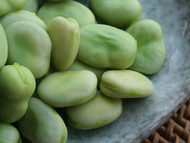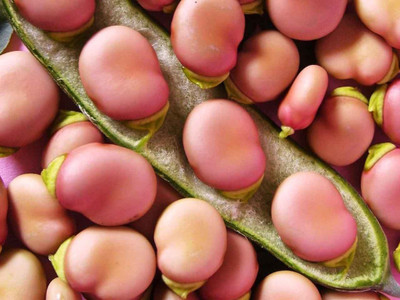How To Grow Broad Beans

Broad beans are the simplest thing to grow. They are hardy and produce a large crop of delicious beans. I prefer to pick them young for a sweeter bean which are lovely tossed into a salad. You can eat them (pods and all) when young (4-5 inches), or pop the bigger ones and extract the beans by running your finger through their fluffy insides.
Many people also peel the outer skin from the bean, but I feel life is way too short for that. Try stir frying the beans with a little chilli and spring onions for a quick and tasty side dish.
There are 2 types of broad bean, 'Longpods' and 'Windsors'. They are both hardy but longpods are hardier, so suitable for overwintering or early sowing. The Windsor varieties are not as high yielding but are viewed by broad bean connoisseurs as having a better flavour.
Recommended Broad Bean Varieties:
Witkeim Manita The variety of broad bean seedling we grow in our nursery, Witkeim Manita is a quick and easy cropper. It's a high-yielding and very hardy variety, producing compact pods with roughly 5 beans per pod. A great option for sping sowing.

Witkeim Manita - Broad Bean
View ProductAquadulce Claudia A good variety for November or early December sowing due to its formidable cold hardiness. Reliable yields of delicious white seeded beans in pods up to 23cm long.
Karmazyn A newer favourite of ours, not least due to the novel pink colour (which turns a shade of purple when cooked). Karmazyn has a compact habit and can grow as high as 60cm.
Masterpiece Green Longpod A spring variety and winner of the RHS Garden of Merit Award, Masterpiece Longpod produces up to 7 beans per pod, with excellent flavour; pick when young for the most tender beans. High yields over a long harvesting period.

Broad Beans Growing Guide
When sowing broad beans you need to make sure you have the correct variety for autumn or Spring sowing; check the pack.
Site & Soil
Broad beans grow best in a sunny situation, sheltered from winds. They enjoy rich, moisture-retentive, well-drained soil.
Soil preparation
Prepare the planting site by digging over and adding leaf mould or well-rotted manure. Choose the broad bean variety that suits your needs: e.g. hardy cultivars for early autumn sowings or dwarf broad beans for windy areas.

Bean, Broad 'Aquadulce Claudia'
View ProductSowing Seed Direct:
Sow outside from late February till late April. Your soil should be well dug and reasonably fertile. Sow your beans in 5cm deep drills, at a spacing of 15cm between plants and 45 cm between rows.
Drills
Drills are mini trenches scooped in prepared soil in which you plant your seeds. Don't forget when you scoop out your drill that the soil piled either side will make it look a little deeper than it actually is.

The Chillington Ridging Hoe (Azada) With Handle
View ProductSowing Seeds Under Cover:
Sowing broad beans under cover can give more reliable germination, especially if you have trouble with waterlogged or frozen soil or even pests like mice. It also means you can choose to plant them out on a day when conditions are perfect.
Module sown beans will be ready 4 weeks ahead of those sown as seed giving me an extended harvest time. Broad beans germinate quickly in trays and are vigorous growers, so make an optimistic start to the season!

From mid February till mid April, sow one per cell in a 6 cell modular tray filled with a good multi-purpose compost. Sow in a tray with a size of 3 inches in each module.
Alternatively, rootrainers can be a great way to propagate broad beans. These reusable modules are designed for deep-rooted crops like broad beans and other legumes. the great advantage is that the extra depth (as well as grooves on the inner walls) helps the roots to keep growing straight instead of reaching a dead end and beginning to curl.

Deep Rootrainers
View ProductBroad beans are very cold hardy but they will need a little heat to assist germination if the weather is cold; either on a warm windowsill or in a heated propagator. For November or early December sowing, use the variety Aquadulce claudia.
You can use any good multi purpose compost. (Please use peat free compost if you can get it).

Water in and place in a cool but frost-free tunnel or greenhouse. Avoid heated rooms or hot greenhouses, as they will fail to germinate. Harden off before planting out: It is important to get your plants used to outside temperatures by leaving them out during the day for the week coming up to planting time.
Space 15cm between plants and 45cm between rows.
To plant out your seedling, make a hole in the soil the approximate size of the seedling 'plug'. You need to push the soil in around the roots firmly with your fingers to get good contact with the soil. Don't firm down on the top of the soil, as this can compact the surface and prevent moisture getting down to the plants roots.

Dibber Svarog
View ProductWater the plants after planting but do not soak them.
Autumn Sowing
You can sow broad beans from late September till early November. By sowing in Autumn you can have beans as early as May, but watch out for frost as this can easily claim your hard work. Cloches, polytunnels or fleece are worth keeping on standby just in case the temperature drops.

Pests and Diseases
The most common pest affecting broad beans is blackfly. You will see small black aphids crowded around the growing tip (top of the plant). When the bean plant is fully grown and has started to produce beans, the tip can removed as a control method.
If your beans suffer from blackfly when still young, spray with an organic pest control spray.
Chocolate spot is likely to effect beans later in the season; you will notice characteristic brown spots on the leaves. Good drainage, air flow and soil fertility is good preventative practice, but hopefully you will have harvested most of your beans before the disease hits.

Ecofective Bug Control 1 Litre
View Product
Broad Bean Supports and Crop Care
As the plants grow, you will need to stake them to prevent the fragile stems from bending or breaking and pods being damaged. Broad beans are tall, top heavy plants, and will likely fall over in strong wind or heavy rain.
To support them you can build simple 'boxing ring' style structures with twine. You're best to do this before the plants have filled out. Stake after the seedlings are up, about 12 inches in height, and use anything from pea sticks to bamboo with string to support the plant.

If you have broad bean seedlings that have got a bit tall and gangly, you can bury the first set of leaves and stem to produce a stockier plant; otherwise the stems can break on a windy day.
Dwarf varieties will need less space and less staking, and are well worth considering - especially on windy or small sites.

Bamboo Canes 1.2m - Pack of 20
View ProductHarvesting
You should be harvesting your beans from June till August. Pods can be harvested early at about 2-3 inches long; you can cook these whole without removing the beans. For shelling, pick the pods at about 6 inches long: you don't want the beans to reach their full size because they will become large and tough.
Pick from the bottom up when ripe, and continue to harvest frequently. Finger-thick beans can be eaten whole, or wait until the pod bursts open to harvest the fully ripe beans inside. You should be able to pick them once or twice a week, so keep an eye on maturing beans.

Remove the pods from the stem using a sharp downward twist. Pulling without twisting can damage the stem and encourage disease.
Broad beans are members of the legume family, which take nitrogen from the air and store it in their roots. Leafy plants like cabbages, broccoli and sprouts love nitrogen, so they are ideal crops to plant in the bean space the following year.

Karmazyn Broad Bean
View ProductWhen cropping has finished and you have no more beans, cut the tops down to ground level but leave the roots in the ground. The roots will rot down and release their stored nitrogen into the soil.
Broad beans are great for storing. You can dry or freeze the beans. To freeze, pick fresh, pod, place in a plastic bag and freeze. To dry, pick, pod and lay out the beans in a dry place. Leave beans to completely dry and store in an air tight container. These can be sown next year or re-hydrated for use in cooking.





